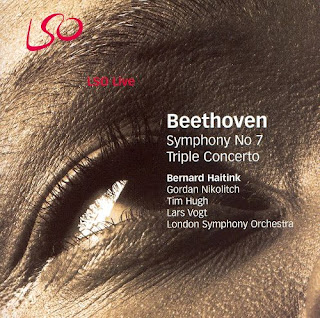 |
| That disc. (C) London Symphony Orchestra |
Haitink didn't 'do' antiphonal violins, did he? Not that I can recall. It was as though he'd been awaiting this moment to 'come out' as an antiphonalist in spectacular style. I realise 'antiphonalist' is not actually a word, by the way, but if it did it would almost certainly describe me. Back in 2006, not many symphony orchestras were arranged with antiphonal violins regularly and very few were recorded as such. At the time I was in the process of establishing my own orchestra, Eroica Camerata, and it felt like quite the act of rebellion to seat them in this way from the outset. Players and audience members alike were somewhat bemused but generally accepted the arrangement at the least as a 'period quirk'. Little did most of them know, or even recall, that almost all symphony orchestras were seated this way until the middle of the twentieth century.
After Haitink's revelatory Beethoven symphony cycle, there have followed many more. Who would have thought there was an appetite for these before this set was released? What is most notable for me, however, is the fact that almost every high profile, modern instrument, Beethoven symphony cycle since then has featured antiphonal violins. Dare I ask, but was this the moment when the traditional orchestral layout became fashionable again?
Since then, we have also seen a steady stream of conductors converted to antiphonal violins. Haitink was not the first in this respect, with Rattle, Barenboim and Gergiev before him. Nevertheless, there followed Vänskä, (Paavo) Järvi, Chailly, Blomstedt, Oramo, Dudamel, Adès, Nagano, Karabits, Collon, to name but some. Not all of these maestros adopt this layout in all repertoire but progress has been made.
It's not only Beethoven symphony cycles that have gone this way. It's the de rigeur arrangement for Schumann, Brahms, Mozart, Mendelssohn, Mahler and Elgar symphony releases these days. Sure, there are one or two sticks in the mud: Vasily Petrenko and Andris Nelsons spring to mind. Having said that, even Nelsons is having to utilise the arrangement in Leipzig where the Gewandhausorchester appear to have adopted antiphonal violins as a corporate layout since the Chailly era. Good on them.
 |
| Mirga goes antiphonal. (C) City of Birmingham Symphony Orchestra |
There will continue to be a variety of orchestral layouts for as long as orchestras exist - and rightly so. I predict that the traditional, antiphonal, layout in symphony orchestras will return to predominate in the next fifty years, perhaps beyond. I doubt many will mind, the odd cellist perhaps excepted. Some, like me, will be more than happy about it.